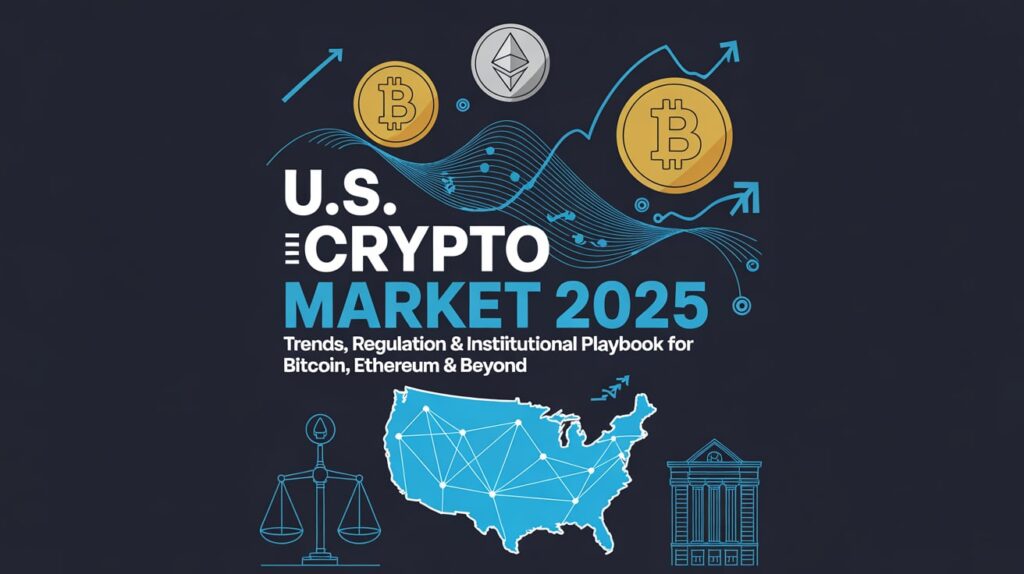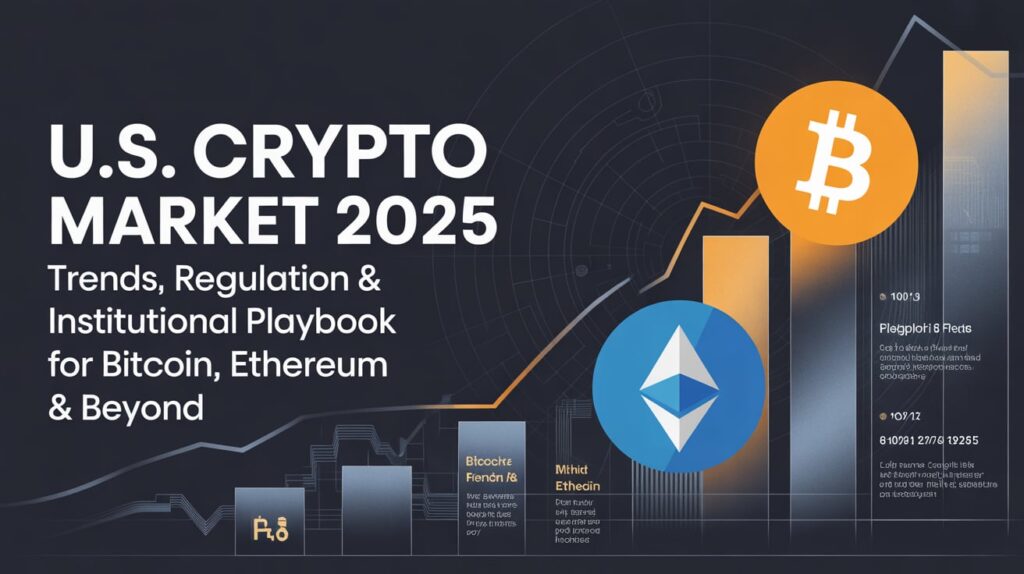U.S. Crypto Market 2025: Trends, Regulation & Institutional Playbook for Bitcoin, Ethereum & Beyond

The U.S. crypto market is at a pivotal juncture in 2025. Amid escalating institutional interest, shifting regulatory frameworks, and evolving consumer sentiment, digital assets are moving from niche speculation toward potential mainstream financial infrastructure. In the United States, developments around spot-crypto exchange-traded funds (ETFs), stablecoin legislation, and infrastructure upgrades are reshaping the landscape. This article provides a deep dive into the current state of the U.S. market, key drivers, major risks, and what investors, developers and stakeholders should monitor as we move forward.
1. Market Snapshot: Where Things Stand
1.1 Market size & growth
The U.S. cryptocurrency market was valued at about USD 9.8 billion in 2024, with forecasts placing it at nearly USD 29.8 billion by 2033 with a compound annual growth rate (CAGR) of ~11.8%. Imarc Group+2Grand View Research+2 Globally, the crypto market cap is measured in trillions of dollars (over USD 3.9 trillion at time of writing) with daily volumes exceeding USD 140–170 billion. CoinMarketCap+2CoinGecko+2
1.2 Consumer adoption & sentiment
In the U.S., recent polling indicates that about 14% of adults report holding cryptocurrency today; many others remain uninterested or view it as risky. Gallup.com On the other hand, deeper reports show changing sentiment: one study cites ~28% of American adults own crypto in 2025, and 67% of current owners plan to buy more. Security.org
1.3 Major assets & dominance
Globally, the dominance of the main asset, Bitcoin (BTC), is still significant — for example, one data-point shows Bitcoin dominance at ~61.2% and Ethereum (ETH) at ~7.11% of coins being tracked. CoinGecko+1
These figures underline that while newer altcoins are growing, the large-cap cryptos maintain a stronghold.
2. Key Drivers in the U.S. Crypto Market
2.1 Institutional adoption
One of the major shifts in the U.S. has been the greater involvement of institutions (asset managers, hedge funds, banks) in the crypto space. This trend is elevating crypto from a retail-only phenomenon to something more systemically relevant. For example, filings showed asset managers increased allocations to U.S. spot Bitcoin ETFs in late 2024. Reuters
2.2 Regulatory clarity (or the promise thereof)
In the U.S., regulation remains one of the biggest variables. At a federal level, there is not yet a completely consistent regulatory framework for digital assets — state-by-state regulation remains highly fragmented. Stevens Center for Innovation in Finance That said, recent legislative moves show momentum. For example, the passage of the GENIUS Act (July 2025) marks one of the first major federal steps toward regulating stablecoins. New York Post+1
2.3 Infrastructure & technological evolution
Blockchain networks, scaling solutions (especially layer-2s), DeFi protocols and stablecoins are evolving rapidly. The 2024 “State of Crypto” report noted that crypto infrastructure has matured: lower transaction costs, faster networks, higher builder “energy”. a16z crypto
2.4 Macro-economic & investment environment
Cryptos are no longer just “wild west” speculation—they are increasingly linked to broader macro trends: inflation hedging, alternative assets, portfolio diversification. The interplay with U.S. monetary policy (e.g., interest rate moves by Federal Reserve) and equity markets also matter greatly.
2.5 Consumer tech adoption & use-cases
Beyond investment, use-cases matter: wallets, payments, DeFi applications, NFTs, gaming. While the adoption levels in the U.S. still leave ample room for growth, the shift from speculation toward utility adds long-term weight to the market.
3. Regulatory & Legal Landscape in the U.S.
3.1 Federal vs State regulation
As noted, while some states in the U.S. have implemented individual frameworks for blockchain and crypto, there is no unified federal regulatory regime yet. Stevens Center for Innovation in Finance+1 This creates both opportunities (innovation, speed) and risks (regulatory uncertainty).
3.2 Landmark legislation: GENIUS Act and others
The GENIUS Act passed in July 2025 is a salient milestone. It mandates oversight and financial transparency for stablecoin issuers, especially those pegged to the U.S. dollar. The Washington Post+1
Other proposed or under-consideration laws include the Digital Commodities Consumer Protection Act (DCCPA), aiming to give clearer jurisdiction and oversight to the Commodity Futures Trading Commission (CFTC). Wikipedia
3.3 Regulatory intervention & market impact
Academic research shows regulatory actions by the U.S. Securities and Exchange Commission (SEC) have measurable impacts on crypto asset returns and trading volumes. One study found that announcements by the SEC resulted in returns dropping ~12% over a week post-announcement. arXiv
3.4 Implications for participants
-
Exchanges and custodians must anticipate stricter compliance, auditing and transparency obligations.
-
Cryptos deemed “securities” may face different rules from those deemed commodities.
-
Stablecoin issuers have a clearer path now—but also higher responsibility.
-
Developers and token issuers should consider jurisdictional risks, especially for U.S.-based offerings.
4. Major Trends and Themes to Watch

4.1 Bitcoin & Ethereum leadership
Bitcoin remains the flagship crypto; Ethereum offers smart-contract utility. Their dominance is likely to persist, but the relative share may shrink as ecosystem diversification grows.
4.2 Rise of Layer2s and scalability solutions
As noted in the 2024 State of Crypto report, layer-2 networks (on top of Ethereum and other chains) have matured—reducing transaction costs, increasing throughput, improving usability. a16z crypto For U.S. developers and investors, this means: look beyond the “top coin” narrative and evaluate infrastructure plays.
4.3 Stablecoins and institutional utility
Stablecoins (USD-pegged and otherwise) are increasingly becoming a “killer app” in crypto—facilitating payments, remittances, DeFi flows, and institutional usage. The regulatory focus in the U.S. signals that stablecoins will no longer be sidelined. a16z crypto+1
4.4 DeFi, tokenization & Web3 adoption
Decentralized finance (DeFi) continues to grow. Tokenization—of assets, real-estate, commodities—is increasing interest. U.S. investors and developers should pay attention to interoperability with the traditional financial system.
4.5 Macro and portfolio role of crypto
These days, cryptocurrencies are increasingly viewed as part of a diversified portfolio: alternative assets, hedges, or speculative growth plays. Their correlation with traditional assets is evolving (sometimes increasing), so risk-management becomes critical.
4.6 Risk, volatility and maturity of the market
It’s essential to keep in mind: crypto remains volatile, evolving, and subject to both technological and regulatory shocks. The U.S. market is maturing—but by no means “stable” in the classical sense.
5. US Market – Key Metrics & Sentiment Insights
5.1 Market cap & volumes
Global crypto market cap hovers above USD 3.9 trillion, with daily volumes in the range of USD 140-180 billion. CoinMarketCap+2CoinGecko+2
5.2 Ownership and demographics
In the U.S., around 14% of adults report owning crypto. Gallup.com Yet other figures suggest a higher number of ~28% ownership among those familiar with crypto in 2025. Security.org Ownership is higher among younger adults, males, and those comfortable with digital assets.
5.3 Sentiment & confidence
Sentiment is rising—but it remains cautious. Many investors still view crypto as higher-risk. The regulatory push and institutional entry are positive signals, but perception of risk remains a barrier.
5.4 Regulatory posture and market responses
As mentioned above, regulatory clarity tends to boost market confidence, whereas uncertainty or crack-downs result in sharp negative moves. For instance, recent studies show a measurable drop in returns following regulatory announcements. arXiv
5.5 State-by-state variation
Within the United States, crypto regulation varies significantly by state—adding complexity for companies operating across borders. Stevens Center for Innovation in Finance
5.6 Outlook for growth
The U.S. crypto market growth prospects remain strong—driven by institutional adoption, technology advances, and consumer interest. Forecasts suggest a high-teens CAGR through much of this decade. Imarc Group
6. Risk Factors & Headwinds
6.1 Regulatory uncertainty
While progress is being made, the lack of a fully unified regulatory framework means uncertainty remains. Unforeseen regulatory enforcement, classification of tokens as securities, or abrupt changes in policy could impact markets.
6.2 Technological and security risks
Blockchain networks face scalability, interoperability, and security issues. Hacks, exploits and failures in smart contracts remain real threats.
6.3 Macro-economic environment
Cryptos are increasingly correlated with traditional assets; thus factors like interest rates, inflation, economic slowdowns, and regulatory moves (e.g., by the Fed) will impact performance.
6.4 Market maturity & competition
As the industry matures, competition increases. Not all projects will succeed—many may fail to deliver utility, or fade as speculative plays. Investors should remain discerning.
6.5 Adoption hurdles & perception
Main-street adoption still lags. As one poll showed, many Americans view crypto as highly risky and are not planning to buy. Gallup.com Overcoming trust, usability, regulation and education barriers remains critical.
6.6 Environmental & ESG concerns
Mining (especially proof-of-work) faces scrutiny from environmental and regulatory fronts. Projects and investors must address sustainability and governance concerns to gain broader acceptance.
7. Strategic Considerations for Investors & Developers
7.1 For investors
-
Risk management: Even in the U.S., although institutional money is entering, crypto remains volatile—allocate accordingly.
-
Diversification: Consider balancing large-cap coins (e.g., BTC, ETH) with select smaller projects (layer-2s, infrastructure) but be mindful of risk.
-
Regulation watch: Stay tuned to regulatory developments in the U.S.—laws like the GENIUS Act or any SEC/CFTC clarifications can act as catalysts (positive or negative).
-
Macro context: Recognize that crypto doesn’t exist in a vacuum—the broader economy, interest rates, inflation, and equity markets impact crypto flows.
7.2 For developers / projects
-
Compliance & jurisdiction: If operating in or targeting U.S. users, understand the regulatory landscape—state and federal.
-
Utility & infrastructure: Projects that deliver real-world utility, scalability, interoperability stand better long-term than pure speculation.
-
Governance & transparency: Being ahead of compliance and having clear token economics, governance models and auditability will build trust.
-
Institutional readiness: As institutions participate more, being “institutionally ready” (custody, KYC/AML, regulatory alignment) can open doors.
7.3 For traditional finance & institutions
-
Entry strategy: For banks, asset managers and fintechs, evaluating how to integrate crypto (custody, ETFs, payments) is key.
-
Risk & compliance frameworks: Must be built to accommodate digital-asset specific risks (cyber, smart contracts, regulatory).
-
Collaboration with tech: Working with blockchain infra, DeFi protocols, and layer-2 networks can unlock growth beyond trading/speculation.
8. Looking Ahead: What to Watch in 2025-26

8.1 ETF and institutional products
The approval and uptake of spot crypto ETFs in the U.S. will be pivotal. These products can unlock institutional capital and broaden access.
8.2 Stablecoin evolution
With laws like the GENIUS Act, stablecoins are poised to become far larger in scale and utility. How they integrate with banking, payments, DeFi will matter.
8.3 Regulatory milestones
Key regulatory moves (classification of tokens, cross-border regulatory cooperation, state vs federal law harmonisation) will shape market sentiment.
8.4 Layer-2 & infrastructure explosion
Watch for projects that scale blockchain networks, reduce fees, improve UX. This could be a major driver of adoption.
8.5 Tokenization of real-world assets
Real-estate, commodities, intangible assets—tokenization is still nascent in the U.S., but could be a multi-trillion opportunity.
8.6 Institutional integration & treasury usage
Corporations, institutions, even national treasuries may increasingly hold crypto or crypto-adjacent assets. This can change the supply/demand dynamics.
8.7 Sentiment & retail flows
Retail adoption still has runway. How mainstream platforms (fintechs, brokerages) integrate crypto will affect flows and volumes.
8.8 Technological & security breakthroughs
Advances in decentralised identity, privacy, cross-chain interoperability, quantum‐resistance, etc., may determine which projects dominate next.
9. Case Studies & Illustrative Examples
9.1 Regulatory action & market reaction
Research shows that SEC announcements and regulatory interventions in the U.S. crypto space have measurable negative impacts on returns and volumes. For example, returns dropping ~12% over the week post-announcement. arXiv
9.2 Consumer adoption data
Despite the rapid growth in crypto, one Gallup poll found only ~14% of U.S. adults report owning cryptocurrency, with many remaining skeptical of its risk. Gallup.com
Meanwhile, deeper adoption data suggests ~28% ownership among American adults in 2025 (though this figure depends on survey methodology). Security.org
9.3 Market size forecasts
The U.S. market being valued at ~USD 9.8 billion in 2024 and projected to reach ~USD 29.8 billion by 2033 suggests strong growth—but also shows this asset class remains small compared to global financial markets. Imarc Group
9.4 Infrastructure maturity
The 2024 “State of Crypto” report highlights how usage, builder activity and infrastructure in the U.S. has reached all-time highs, supporting a narrative of maturation. a16z crypto
9.5 Stablecoin regulation shift
The passage of the GENIUS Act in mid-2025 marked a regulatory milestone—the first major federal law in the U.S. aimed at crypto assets (specifically stablecoins) and signaling a transition toward more mainstream integration. New York Post+1
10. Practical Advice: What Should U.S.-based (or U.S.*-targeting) Crypto Stakeholders Do?
10.1 For investors
-
Regularly monitor regulatory developments—not just token mechanics or project fundamentals.
-
Use proper risk-management: allocate what you can afford to lose; don’t treat crypto as guaranteed growth.
-
Consider wallets, custody, tax implications (in the U.S., crypto is taxable and regulatory scrutiny is increasing).
-
Stay diversified: beyond just “buy Bitcoin and forget”, think about the infrastructure, layer-2s, utility tokens.
10.2 For developers & founders
-
Ensure your token/contract design contemplates U.S. jurisdictions if you plan to engage with U.S. users.
-
Prioritise security, audits, compliance and KYC/AML if relevant.
-
Think utility first: What problem are you solving? What niche or infrastructure gap are you filling?
-
Consider partnerships with institutions or fintechs—these can accelerate growth in the U.S. context.
10.3 For traditional finance & fintech
-
Explore integrating crypto options for clients: trading, custody, payments, treasury.
-
Build compliance expertise: crypto adds new wrinkle to risk frameworks.
-
Partner with blockchain infra: not every bank will build from scratch—collaboration may be key.
10.4 For regulators & policymakers (insight)
-
Recognise the trade-off: innovation vs. protection. Unclear regulation stifles innovation; overly heavy regulation may push activity overseas.
-
Coordinate across state/federal lines: fragmentation increases compliance cost and risk.
-
Encourage transparency: as crypto integrates with mainstream finance, transparency and auditability will determine trust.

11. The Big Picture: What This Means for the Future
The U.S. crypto market is transitioning from “early adopter / speculator” mode toward a phase of infrastructure build-out, institutional integration, and regulatory maturation. If the right conditions align—clearer regulation, improved infrastructure, institutional capital flows—then crypto could increasingly become part of the core financial ecosystem.
However, the path is far from guaranteed. Market sentiment is still fragile, technological risks remain, regulation is evolving and competition is fierce. The winners will likely be those projects, companies and institutions that navigate these interlocking domains (technology, regulation, adoption) effectively.
For U.S. investors, this means paying attention not just to token price charts, but to regulatory signals, institutional flows, infrastructure development and broader economic context. For developers, it means building utility, compliance, and scalability from the start. For institutions and fintechs, it means preparing internal structures and partnerships to safely engage with digital assets.
In essence: this is not a “crypto bubble story” only—it may become a story of financial infrastructure evolution. The United States has a major role to play in how that story unfolds.
Conclusion
In 2025, the U.S. crypto market is at an inflection point. The pieces are in place: institutional interest, technological advancement, regulatory momentum. But success is not pre-ordained. Risk remains high, adoption still has a long runway, and regulatory clarity is still in flux. Stakeholders who keep a strategic, informed and disciplined approach will be better positioned to ride the next wave of this evolving asset class.
Whether you’re an investor, developer, institution or observer, understanding the U.S. market’s unique mix of opportunity and challenge is critical.